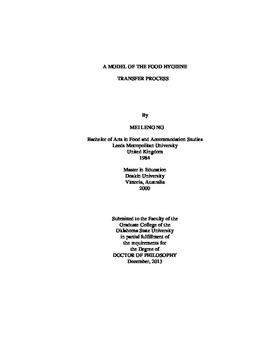| dc.contributor.advisor | Qu, Hailin | |
| dc.contributor.author | Ng, Mei Leng | |
| dc.date.accessioned | 2015-06-17T20:07:18Z | |
| dc.date.available | 2015-06-17T20:07:18Z | |
| dc.date.issued | 2013-12 | |
| dc.identifier.uri | https://hdl.handle.net/11244/15040 | |
| dc.description.abstract | Analyses of food-borne disease notification throughout the world have confirmed that there is a link between outbreaks and unsafe food handling practices in the foodservice industry. For many years industry has relied on knowledge based food hygiene education and training to prompt foodservice employees to become engaged with food hygiene and safety. However, research to date (Mathias, Riben, Campbell, Wiens, 1994; Powell et al., 1997) suggested that knowledge conveyed by traditional training courses cannot be assumed to bring about desired behavioral changes. The purpose of this research was to study the effects of training input on knowledge and attitude of foodservice employees' in Hong Kong and how these effects were translated into food hygiene and safety practice in the workplace. Baldwin and Ford's (1988) transfer process model was adopted. It was redefined; pre-disposing factors of course's relevance, trainee characteristics and work environment were retained. Training outputs were replaced with theoretical concepts of knowledge, attitude and behavior and criterion measures were included based on Kirkpatrick's (1967) four level evaluation model. A survey questionnaire was developed and distributed to foodservice employees of Chinese and Western operations in Hong Kong. 391 responses were collected and analyzed using structural equation modelling and descriptive statistics. The research established two distinct and independent relationships which are the direct relationship between knowledge and attitude, and the direct relationship between training input and behavior. Foodservice employees' perceptions of their knowledge and training input were strong but weak in their behavior and attitude. The results suggested that training is an important food hygiene and safety control tool. It is recommended that management incorporate formal training as well as refresher courses in their food safety management system. Although knowledge was affirmed to affect attitude but a "gap" exist between attitude and behavior. Since the desired outcome is behavior, it is important to tap into the motivational factors and personal beliefs of foodservice employees. For relevant and effective transfer of food hygiene and safety, organization support, adequate resources and peer support are needed to produce desired effect on foodservice employees' intention and actual behavior to carry out safe working practices. | |
| dc.format | application/pdf | |
| dc.language | en_US | |
| dc.rights | Copyright is held by the author who has granted the Oklahoma State University Library the non-exclusive right to share this material in its institutional repository. Contact Digital Library Services at lib-dls@okstate.edu or 405-744-9161 for the permission policy on the use, reproduction or distribution of this material. | |
| dc.title | Model of the food hygiene transfer process | |
| dc.contributor.committeeMember | Leong, Jerrold | |
| dc.contributor.committeeMember | Ryan, Bill | |
| dc.contributor.committeeMember | Ownbey, Shiretta | |
| osu.filename | Ng_okstate_0664D_13167.pdf | |
| osu.accesstype | Open Access | |
| dc.type.genre | Dissertation | |
| dc.type.material | Text | |
| dc.subject.keywords | food hygiene | |
| dc.subject.keywords | food safety | |
| dc.subject.keywords | foodservice employees | |
| dc.subject.keywords | structural model | |
| dc.subject.keywords | training | |
| dc.subject.keywords | transfer process | |
| thesis.degree.discipline | Hospitality Administration | |
| thesis.degree.grantor | Oklahoma State University | |
